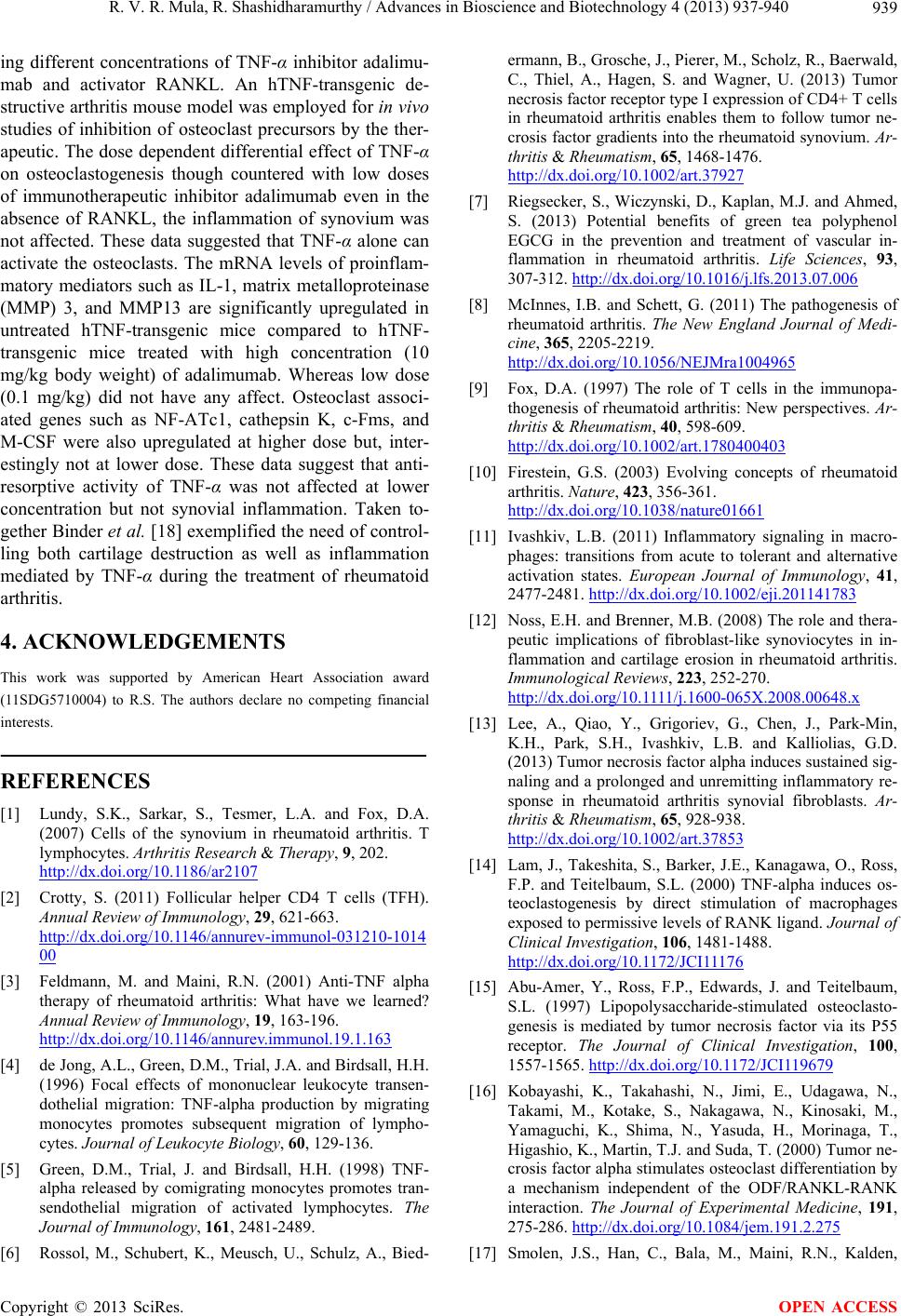
R. V. R. Mula, R. Shashidharamurthy / Advances in Bioscience and Biotechnology 4 (2013) 937-940 939
ing different concentrations of TNF-α inhibitor adalimu-
mab and activator RANKL. An hTNF-transgenic de-
structive arthritis mouse model was employed for in vivo
studies of inhibition of osteoclast precursors by the ther-
apeutic. The dose dependent differential effect of TNF-α
on osteoclastogenesis though countered with low doses
of immunotherapeutic inhibitor adalimumab even in the
absence of RANKL, the inflammation of synovium was
not affected. These data suggested that TNF-α alone can
activate the osteoclasts. The mRNA levels of proinflam-
matory mediators such as IL-1, matrix metalloproteinase
(MMP) 3, and MMP13 are significantly upregulated in
untreated hTNF-transgenic mice compared to hTNF-
transgenic mice treated with high concentration (10
mg/kg body weight) of adalimumab. Whereas low dose
(0.1 mg/kg) did not have any affect. Osteoclast associ-
ated genes such as NF-ATc1, cathepsin K, c-Fms, and
M-CSF were also upregulated at higher dose but, inter-
estingly not at lower dose. These data suggest that anti-
resorptive activity of TNF-α was not affected at lower
concentration but not synovial inflammation. Taken to-
gether Binder et al. [18] exemplified the need of control-
ling both cartilage destruction as well as inflammation
mediated by TNF-α during the treatment of rheumatoid
arthritis.
4. ACKNOWLEDGEMENTS
This work was supported by American Heart Association award
(11SDG5710004) to R.S. The authors declare no competing financial
interests.
REFERENCES
[1] Lundy, S.K., Sarkar, S., Tesmer, L.A. and Fox, D.A.
(2007) Cells of the synovium in rheumatoid arthritis. T
lymphocytes. Arthritis Research & Therapy, 9, 202.
http://dx.doi.org/10.1186/ar2107
[2] Crotty, S. (2011) Follicular helper CD4 T cells (TFH).
Annual Review of Immunology, 29, 621-663.
http://dx.doi.org/10.1146/annurev-immunol-031210-1014
00
[3] Feldmann, M. and Maini, R.N. (2001) Anti-TNF alpha
therapy of rheumatoid arthritis: What have we learned?
Annual Review of Immunology, 19, 163-196.
http://dx.doi.org/10.1146/annurev.immunol.19.1.163
[4] de Jong, A.L., Green, D.M., Trial, J.A. and Birdsall, H.H.
(1996) Focal effects of mononuclear leukocyte transen-
dothelial migration: TNF-alpha production by migrating
monocytes promotes subsequent migration of lympho-
cytes. Journal of Leukocyte Biology, 60, 129-136.
[5] Green, D.M., Trial, J. and Birdsall, H.H. (1998) TNF-
alpha released by comigrating monocytes promotes tran-
sendothelial migration of activated lymphocytes. The
Journal of Immunology, 161, 2481-2489.
[6] Rossol, M., Schubert, K., Meusch, U., Schulz, A., Bied-
ermann, B., Grosche, J., Pierer, M., Scholz, R., Baerwald,
C., Thiel, A., Hagen, S. and Wagner, U. (2013) Tumor
necrosis factor receptor type I expression of CD4+ T cells
in rheumatoid arthritis enables them to follow tumor ne-
crosis factor gradients into the rheumatoid synovium. Ar-
thritis & Rheumatism, 65, 1468-1476.
http://dx.doi.org/10.1002/art.37927
[7] Riegsecker, S., Wiczynski, D., Kaplan, M.J. and Ahmed,
S. (2013) Potential benefits of green tea polyphenol
EGCG in the prevention and treatment of vascular in-
flammation in rheumatoid arthritis. Life Sciences, 93,
307-312. http://dx.doi.org/10.1016/j.lfs.2013.07.006
[8] McInnes, I.B. and Schett, G. (2011) The pathogenesis of
rheumatoid arthritis. The New England Journal of Medi-
cine, 365, 2205-2219.
http://dx.doi.org/10.1056/NEJMra1004965
[9] Fox, D.A. (1997) The role of T cells in the immunopa-
thogenesis of rheumatoid arthritis: New perspectives. Ar-
thritis & Rheumatism, 40, 598-609.
http://dx.doi.org/10.1002/art.1780400403
[10] Firestein, G.S. (2003) Evolving concepts of rheumatoid
arthritis. Nature, 423, 356-361.
http://dx.doi.org/10.1038/nature01661
[11] Ivashkiv, L.B. (2011) Inflammatory signaling in macro-
phages: transitions from acute to tolerant and alternative
activation states. European Journal of Immunology, 41,
2477-2481. http://dx.doi.org/10.1002/eji.201141783
[12] Noss, E.H. and Brenner, M.B. (2008) The role and thera-
peutic implications of fibroblast-like synoviocytes in in-
flammation and cartilage erosion in rheumatoid arthritis.
Immunological Reviews, 223, 252-270.
http://dx.doi.org/10.1111/j.1600-065X.2008.00648.x
[13] Lee, A., Qiao, Y., Grigoriev, G., Chen, J., Park-Min,
K.H., Park, S.H., Ivashkiv, L.B. and Kalliolias, G.D.
(2013) Tumor necrosis factor alpha induces sustained sig-
naling and a prolonged and unremitting inflammatory re-
sponse in rheumatoid arthritis synovial fibroblasts. Ar-
thritis & Rheumatism, 65, 928-938.
http://dx.doi.org/10.1002/art.37853
[14] Lam, J., Takeshita, S., Barker, J.E., Kanagawa, O., Ross,
F.P. and Teitelbaum, S.L. (2000) TNF-alpha induces os-
teoclastogenesis by direct stimulation of macrophages
exposed to permissive levels of RANK ligand. Journal of
Clinical Investigation, 106, 1481-1488.
http://dx.doi.org/10.1172/JCI11176
[15] Abu-Amer, Y., Ross, F.P., Edwards, J. and Teitelbaum,
S.L. (1997) Lipopolysaccharide-stimulated osteoclasto-
genesis is mediated by tumor necrosis factor via its P55
receptor. The Journal of Clinical Investigation, 100,
1557-1565. http://dx.doi.org/10.1172/JCI119679
[16] Kobayashi, K., Takahashi, N., Jimi, E., Udagawa, N.,
Takami, M., Kotake, S., Nakagawa, N., Kinosaki, M.,
Yamaguchi, K., Shima, N., Yasuda, H., Morinaga, T.,
Higashio, K., Martin, T.J. and Suda, T. (2000) Tumor ne-
crosis factor alpha stimulates osteoclast differentiation by
a mechanism independent of the ODF/RANKL-RANK
interaction. The Journal of Experimental Medicine, 191,
275-286. http://dx.doi.org/10.1084/jem.191.2.275
[17] Smolen, J.S., Han, C., Bala, M., Maini, R.N., Kalden,
Copyright © 2013 SciRes. OPEN ACCESS